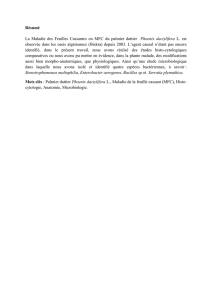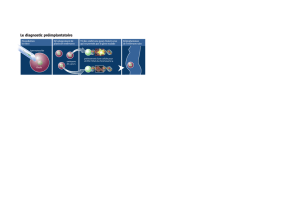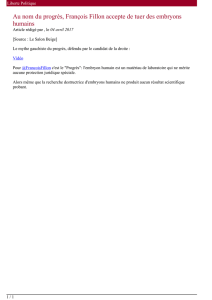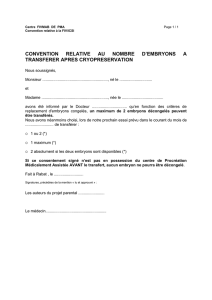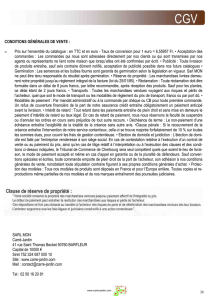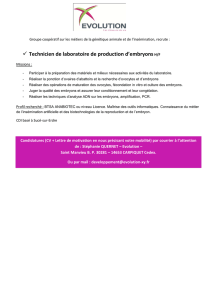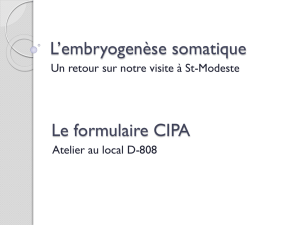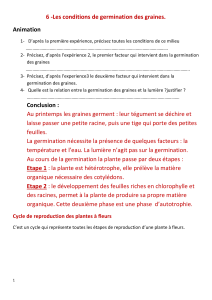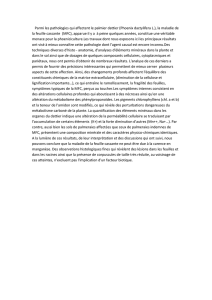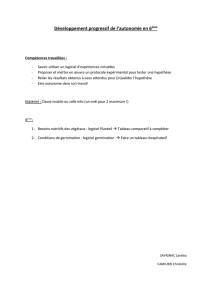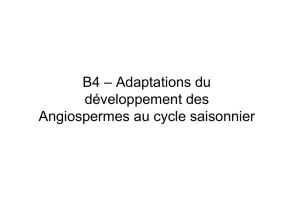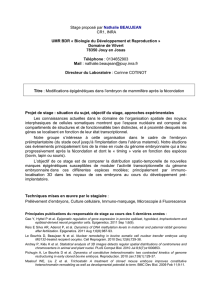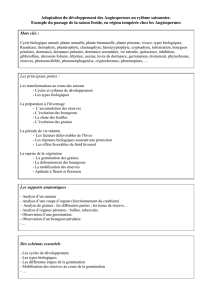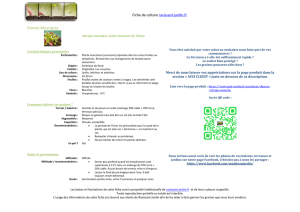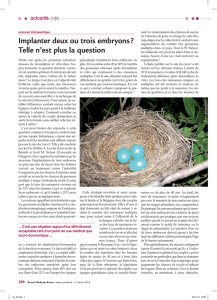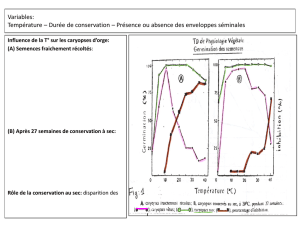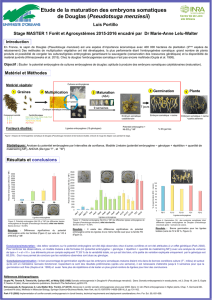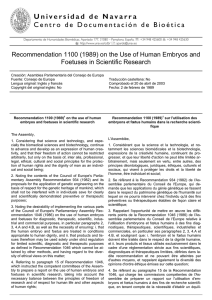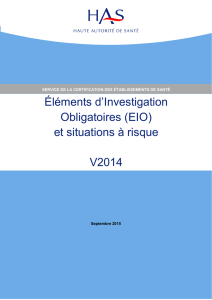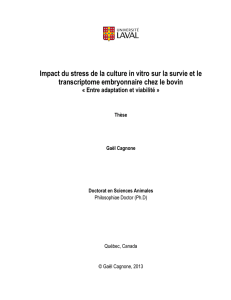Influence des phytohormones et des radiations
publicité
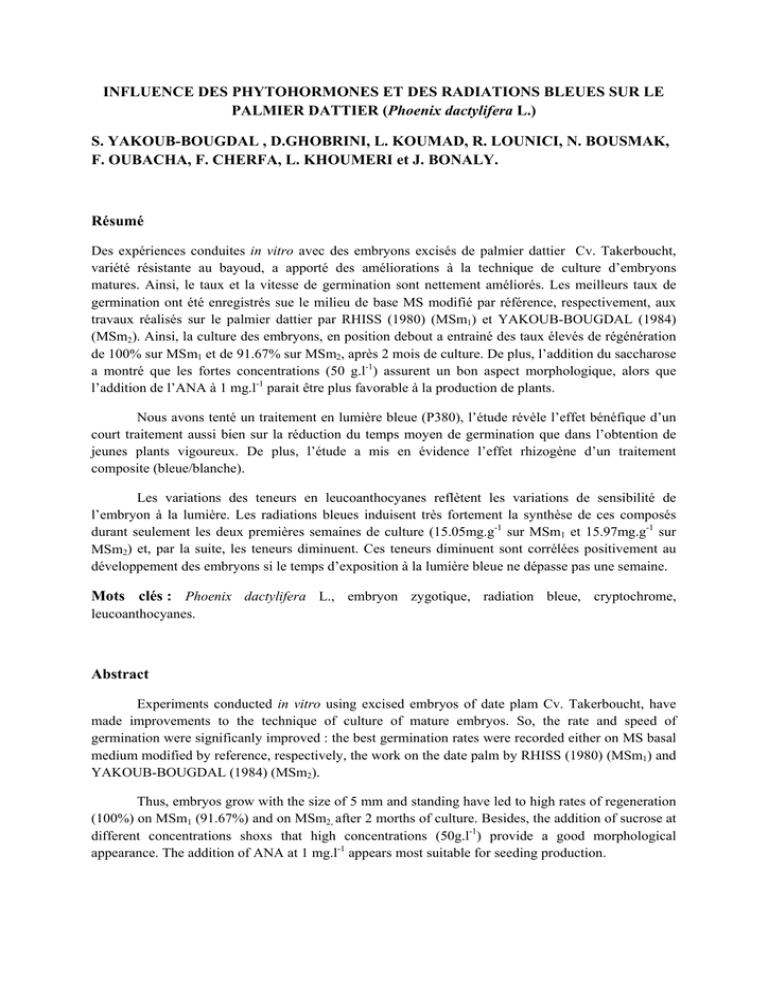
INFLUENCE DES PHYTOHORMONES ET DES RADIATIONS BLEUES SUR LE PALMIER DATTIER (Phoenix dactylifera L.) S. YAKOUB-BOUGDAL , D.GHOBRINI, L. KOUMAD, R. LOUNICI, N. BOUSMAK, F. OUBACHA, F. CHERFA, L. KHOUMERI et J. BONALY. Résumé Des expériences conduites in vitro avec des embryons excisés de palmier dattier Cv. Takerboucht, variété résistante au bayoud, a apporté des améliorations à la technique de culture d’embryons matures. Ainsi, le taux et la vitesse de germination sont nettement améliorés. Les meilleurs taux de germination ont été enregistrés sue le milieu de base MS modifié par référence, respectivement, aux travaux réalisés sur le palmier dattier par RHISS (1980) (MSm1) et YAKOUB-BOUGDAL (1984) (MSm2). Ainsi, la culture des embryons, en position debout a entrainé des taux élevés de régénération de 100% sur MSm1 et de 91.67% sur MSm2, après 2 mois de culture. De plus, l’addition du saccharose a montré que les fortes concentrations (50 g.l-1) assurent un bon aspect morphologique, alors que l’addition de l’ANA à 1 mg.l-1 parait être plus favorable à la production de plants. Nous avons tenté un traitement en lumière bleue (P380), l’étude révèle l’effet bénéfique d’un court traitement aussi bien sur la réduction du temps moyen de germination que dans l’obtention de jeunes plants vigoureux. De plus, l’étude a mis en évidence l’effet rhizogène d’un traitement composite (bleue/blanche). Les variations des teneurs en leucoanthocyanes reflètent les variations de sensibilité de l’embryon à la lumière. Les radiations bleues induisent très fortement la synthèse de ces composés durant seulement les deux premières semaines de culture (15.05mg.g-1 sur MSm1 et 15.97mg.g-1 sur MSm2) et, par la suite, les teneurs diminuent. Ces teneurs diminuent sont corrélées positivement au développement des embryons si le temps d’exposition à la lumière bleue ne dépasse pas une semaine. Mots clés : Phoenix dactylifera L., embryon zygotique, radiation bleue, cryptochrome, leucoanthocyanes. Abstract Experiments conducted in vitro using excised embryos of date plam Cv. Takerboucht, have made improvements to the technique of culture of mature embryos. So, the rate and speed of germination were significanly improved : the best germination rates were recorded either on MS basal medium modified by reference, respectively, the work on the date palm by RHISS (1980) (MSm1) and YAKOUB-BOUGDAL (1984) (MSm2). Thus, embryos grow with the size of 5 mm and standing have led to high rates of regeneration (100%) on MSm1 (91.67%) and on MSm2, after 2 morths of culture. Besides, the addition of sucrose at different concentrations shoxs that high concentrations (50g.l-1) provide a good morphological appearance. The addition of ANA at 1 mg.l-1 appears most suitable for seeding production. We tried a blue ligh treatment (P380), study reveals the beneficial effect of treatment during both the reduction of regeneration in the obtaining of vigorous seedlings. In addition, the study showed the effect of rooting treatment composite (blue/white). Changes in levels leucoanthcyanes reflect variations in sensitivity of the embyi to light during the culture. The blue radiation induced stongly the synthesis of these compounds only during the first two weeks of cukture (15.05mg.g-1 on MSm1 and 15.97mg.g-1 on MSm2), thereafter, levels decrease. There is a positive cerrelation detween the levels of leucoanthocyanins and the developpement of embryos when the bleu-light treatment no exceeds on week. Key words : leucoanthocyanins. Phoenix dactylifera L., zygotic embryo, cryptochrom, blue radiation,
